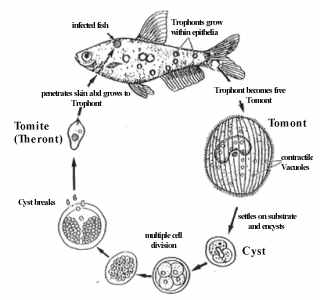
Lifecycle of Ichthyophtirius multifiliis

Lifecycle of Ichthyophtirius multifiliis |
Theronts of Ichthyophthirius multifiliis find their fish hosts with
complex behavior patterns and in response to different chemical signals. The mechanisms of how
parasites find and recognize fish hosts is best known for trematode cercariae. These
multicellular organisms respond with complex behavior patterns to sequences of different
chemical host signals. However, little is known on the host-finding of protozoan parasites.
We therefore studied how the infective theronts of I. multifiliis find their fish hosts
by offering them various fractions and chemical modifications of fish skin surface. Free
swimming theronts showed at least 6 different behavior patterns, 4 of them were stimulated by
fish skin components. The most evident responses, i.e. "stop and orientation" and
"change of direction" were mainly stimulated by amino acids of fish skin surface.
Theronts approached towards solid substrates ("stop and go ahead") in response to
macromolecular glycoproteins of fish skin, and they were repelled ("stop and turn
away") by other macromolecular glycoconjugates. After contact with solid surfaces, they
repeatedly dipped on the surface ("dipping contact") in response to glycoconjugates
of fish skin and they swam along the surface ("body parallel")when it contained
proteins of fish skin. The results demonstrate that also a protozoan parasite without nervous
system and cellular chemoreceptors may show very different host-finding behavior patterns (at
least 11) and may respond to different chemical host cues (at least 5)